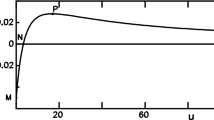Abstract
When the Schrödinger equation for stationary states is studied for a system described by a central potential in n-dimensional Euclidean space, the radial part of stationary states is an even function of a parameter \(\lambda \) which is a linear combination of angular momentum quantum number l and dimension n, i.e., \(\lambda =l+{(n-2)\over 2}\). Thus, without setting a priori \(n=3\), complex values of \(\lambda \) can be achieved, in particular, by keeping l real and complexifying n. For suitable values of such an auxiliary complexified dimension, it is therefore possible to obtain results on scattering amplitude and phase shift that are completely equivalent to the results obtained in the sixties for Yukawian potentials in \(\mathbf{R}^{3}\). Moreover, if both l and n are complexified, the possibility arises of recovering the partial wave amplitude from residues of a function of two complex variables. Thus, the complex angular momentum formalism can be imbedded into a broader framework, where a correspondence exists between the scattering amplitude and a skew curve in \(\mathbf{R}^{3}\).
Similar content being viewed by others
Notes
Recall from Ref. [3] that the potential V(z) is Yukawian if one can express it in the form
$$\begin{aligned} V(z)=\int _{m}^{\infty }C(\mu )e^{-\mu z}\mathrm {d}\mu , \end{aligned}$$where \(C(\mu )\) is a distribution. Other relevant cases occur when \(C(\mu )\) is a function of bounded variation, for which the potential reads as
$$\begin{aligned} V(z)=\int _{m}^{\infty }{e^{-\mu z}\over z}\mathrm {d}C_{\mu }, \end{aligned}$$or when C is an absolutely continuous function with first derivative \(C'(\mu )=\sigma (\mu )\), for which V(z) takes the form
$$\begin{aligned} V(z)=\int _{m}^{\infty }{e^{-\mu z}\over z}\sigma (\mu )\mathrm {d}\mu . \end{aligned}$$The Yukawa potential is recovered from the first formula when \(C(\mu )\) is just a constant.
The assumption of Poincaré is not however too restrictive, since a theorem holds, according to which a function that is meromorphic over the whole of \(\mathbf{C}^{2}\), including the point at infinity, is a rational function [14].
References
T. Regge, Introduction to complex orbital momenta. Nuovo Cim. 14, 951–976 (1959)
A. Bottino, A.M. Longoni, T. Regge, Potential scattering for complex energy and angular momentum. Nuovo Cim. 23, 954–1004 (1962)
V. de Alfaro, T. Regge, Potential Scattering (North-Holland, Amsterdam, 1965)
G.N. Watson, The diffraction of electric waves by the earth. Proc. R. Soc. Lond. 95, 83–99 (1918)
A. Sommerfeld, Partial Differential Equations in Physics (Academic Press, New York, 1949)
A. Bottino, A retrospective look at Regge poles, arXiv:1807.02456 [physics.hist-ph]
A. Chatterjee, Large-N expansions in quantum mechanics, atomic physics ands some \(O(n)\) invariant systems. Phys. Rep. 186, 249–372 (1990)
G. Esposito, Complex parameters in quantum mechanics. Found. Phys. Lett. 11, 535–547 (1998)
E.T. Whittaker, G.N. Watson, Modern Analysis (Cambridge University Press, Cambridge, 1927)
T. Daudé, F. Nicoleau, Local inverse scattering at a fixed energy for radial Schrödinger operators and localization of the Regge poles. Ann. H. Poincaré 17, 2849–2904 (2016)
H. Poincaré, Sur les résidus des intégrales doubles. Acta Math. 9, 321–380 (1887)
J. Leray, Le calcul différentiel et intégral sur une variété analytique complexe. Bull. Soc. Math. France 87, 81–180 (1959)
L.A. Aizenberg and A.P. Yuzhakov, Integral Representations and Residues in Multidimensional Complex Analysis, Transl. Math. Mon. 58 (AMS, Providence, 1983)
R. Caccioppoli, Theory of Functions of Several Complex Variables (Federico II University, Naples, 1947)
V. Del Duca and L. Magnea, The long road from Regge poles to the LHC, arXiv:1812.05829 [hep-ph]
A. Folacci, M. Ould El Hadji, Regge pole description of scattering of scalar and electromagnetic waves by a Schwarzschild black hole. Phys. Rev. D 99, 104079 (2019)
A. Folacci, M. Ould El Hadji, Regge pole description of scattering of gravitational waves by a Schwarzschild black hole. Phys. Rev. D 100, 064009 (2019)
Acknowledgements
The author is grateful to the Dipartimento di Fisica “Ettore Pancini” for hospitality and support. The preprint version of this paper was arXiv:2001.11217 [hep-th].
Author information
Authors and Affiliations
Corresponding author
Rights and permissions
About this article
Cite this article
Esposito, G. Contour and surface integrals in potential scattering. Eur. Phys. J. Plus 135, 501 (2020). https://doi.org/10.1140/epjp/s13360-020-00514-5
Received:
Accepted:
Published:
DOI: https://doi.org/10.1140/epjp/s13360-020-00514-5



